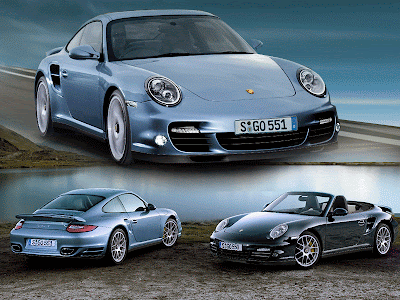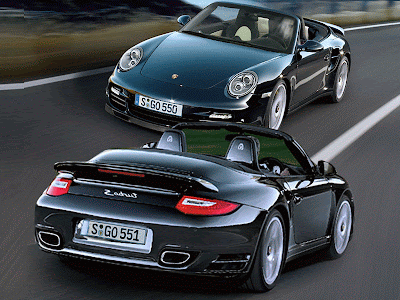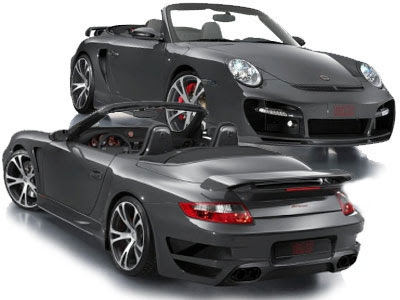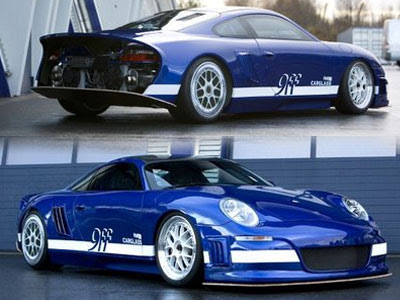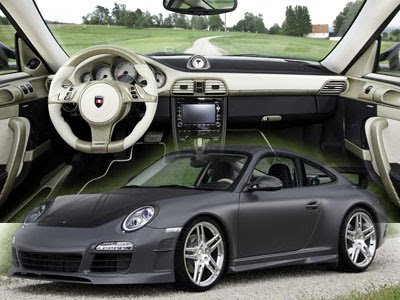Showing posts with label Porsche. Show all posts
Showing posts with label Porsche. Show all posts
Hot on the heels of the facelifted 911 Turbo comes the more extreme 2011 Porsche 911 Turbo S, which will be making its world debut next month at the 2010 Geneva Motor Show before arriving in local showrooms in the second half of the year. The engineers at Dr. Ing. h.c. F. Porsche AG, Stuttgart, have developed a new top-of-the-range sports car for the customer who will only settle for the very best in terms of power, performance and driving dynamics: the 911 Turbo S. The heart of this most exclusive high-performance athlete is of course a six-cylinder boxer boosted by two exhaust gas turbochargers with variable turbine geometry, with an increase in power over the 911 Turbo by 30 to 530 bhp (390 kW).
2011 Porsche 911 Turbo S The most efficient Sports Car
Maximum torque is a most impressive 700 Newton-metres (516 lb-ft). At the same time the 911 Turbo S comes as standard with all high-tech components available only as options on the regular 911 Turbo. In addition to its PDK transmission and all-wheel drive system, the latest 911 Turbo S gets Porsche’s dynamic engine mounts and torque vectoring system with a mechanical differential lock on the rear axle.
Despite its significant increase in power and dynamic performance, the new 911 Turbo S, at 11.4 litres/100 kilometres (equal to 24.8 mpg imp), does not consume any more fuel than the Porsche 911 Turbo, making it by far the most efficient sports car in its performance class.
2011 Porsche 911 Turbo S The most efficient Sports Car
The 911 Turbo S comes exclusively with seven-speed Porsche-Doppelkupplungsgetriebe (PDK) (Porsche’s Double-Clutch Gearbox) conveying drive power to Porsche Traction Management (PTM) all-wheel drive. Driving safety optimised to an even higher standard is ensured by Dynamic Engine Mounts and Porsche Torque Vectoring (PTV) including a mechanical differential lock on the rear axle. In conjunction with Launch Control on the Sport Chrono Package Turbo likewise featured as standard, 911 Turbo S accelerates from a standstill to 100 km/h in 3.3 seconds and reaches 200 km/h in 10.8 seconds. Top speed is 315 km/h or 195 mph. Extra-light and fading-resistant Porsche Ceramic Composite Brakes (PCCB) provide the same outstanding performance in terms of stopping power and controlled application of the brakes.
2011 Porsche 911 Turbo S The most efficient Sports Car
The supreme level of standard equipment including Dynamic Bending Lights, 19-inch wheels in RS Spyder design with central locking, a three-spoke sports steering wheel with gearshift paddles, adaptive sports seats, cruise control, a CD/DVD changer and exclusive twin-tone leather upholstery in Black/Crema or Black/Titanium Blue additionally underlines the outstanding class and calibre of this first Turbo S in five years.
2011 Porsche 911 Turbo S The most efficient Sports Car
The 2011 Porsche 911 Turbo S will go on sale in Europe in both Coupe and Cabriolet variants this May and will arrive in the U.S. later in the year. Expect more details to be revealed following the car’s debut at next month’s Geneva event.
Labels: 2011, Porsche, Sports Car
The next generation Porsche 911 Turbo, Porsche is proud to present a new top model at the pinnacle of its broad range of production sports cars.All key features of this high-performance sports car have been improved significantly and combine far-reaching technical innovations with supreme refinement. As a consequence, the new 911 Turbo offers increased performance, lower weight, enhanced driving dynamics and greater fuel efficiency.With respect to dynamic performance and fuel economy in particular, the next generation Porsche 911 Turbo now stands apart from its competitors even more. The new model will be presented to the public for the first time at the Frankfurt Motor Show from 17 - 27 September, 2009.
The heart and highlight of the seventh generation Porsche 911 Turbo is the new power unit displacing 3.8-litres and delivering maximum output of 500 hp (368 kW). The first entirely new engine in the 35 year history of the Turbo comes with features such as Direct Fuel Injection and twin turbochargers with variable turbine geometry, the latter attribute being unique to Porsche on a petrol engine.
The new six-cylinder engine can be combined with the option of the seven-speed Porsche Doppelkupplungsgetriebe (PDK) double-clutch gearbox; and, for the first time, a further new feature of race car-inspired paddle-shift technology can also be specified. Fitted firmly on the steering wheel, the right paddle is for shifting up through the gears, and the left paddle for shifting down. In conjunction with the optional Sport Chrono Package Turbo, both the paddle-shift steering wheel and the PDK steering wheel with its shift buttons feature integrated displays for Launch Control and the Sport/Sport Plus mode.
This unique combination of supreme technical features ensures an unprecedented standard of responsiveness, agility, performance and efficiency. For example, the new Porsche 911 Turbo reduces CO2 emissions versus its predecessor by almost 18 per cent and therefore ranks unique in its segment in this respect also.
Depending on the configuration of the car, the new 911 Turbo offers fuel consumption ranging between 24.1 - 24.8 mpg (equal to 11.7 - 11.4 litres/100 km) under the EU5 standard. This is all the more remarkable considering the potential for the Porsche 911 Turbo to accelerate from 0-62mph (100 km/h) in 3.4 secs. Top speed, in turn, is 194 mph (312 km/h.)
Owners of the new Porsche 911 Turbo will also enjoy a further improvement in driving dynamics, with detailed enhancement of the Porsche Traction Management (PTM) fully-controlled all-wheel drive and Porsche Stability Management (PSM) being further supported by the new option of Porsche Torque Vectoring (PTV).
Porsche Torque Vectoring makes the car even more agile and precise in its steering responses, particularly on twisting roads.The next generation Porsche 911 Turbo Coupé and Cabriolet go on sale in the UK and Ireland on November 21 2009, priced from £101,823 for the Coupé and £109,048 for the Cabriolet. Standard equipment includes the touch-screen Porsche Communication Management system with both Bluetooth mobile telephone and i-Pod connectivity. Also fitted to every 911 Turbo is a Porsche Vehicle Tracking System (VTS), a sophisticated vehicle security package approved to Thatcham Category 5 standard.
Customers will also be able to explore the dynamic attributes of the new 911 Turbo, and develop their own skills behind the wheel, courtesy of a Driving Experience Programme at the Porsche Experience Centre at Silverstone.
The new six-cylinder engine can be combined with the option of the seven-speed Porsche Doppelkupplungsgetriebe (PDK) double-clutch gearbox; and, for the first time, a further new feature of race car-inspired paddle-shift technology can also be specified. Fitted firmly on the steering wheel, the right paddle is for shifting up through the gears, and the left paddle for shifting down. In conjunction with the optional Sport Chrono Package Turbo, both the paddle-shift steering wheel and the PDK steering wheel with its shift buttons feature integrated displays for Launch Control and the Sport/Sport Plus mode.
This unique combination of supreme technical features ensures an unprecedented standard of responsiveness, agility, performance and efficiency. For example, the new Porsche 911 Turbo reduces CO2 emissions versus its predecessor by almost 18 per cent and therefore ranks unique in its segment in this respect also.
Depending on the configuration of the car, the new 911 Turbo offers fuel consumption ranging between 24.1 - 24.8 mpg (equal to 11.7 - 11.4 litres/100 km) under the EU5 standard. This is all the more remarkable considering the potential for the Porsche 911 Turbo to accelerate from 0-62mph (100 km/h) in 3.4 secs. Top speed, in turn, is 194 mph (312 km/h.)
Owners of the new Porsche 911 Turbo will also enjoy a further improvement in driving dynamics, with detailed enhancement of the Porsche Traction Management (PTM) fully-controlled all-wheel drive and Porsche Stability Management (PSM) being further supported by the new option of Porsche Torque Vectoring (PTV).
Porsche Torque Vectoring makes the car even more agile and precise in its steering responses, particularly on twisting roads.The next generation Porsche 911 Turbo Coupé and Cabriolet go on sale in the UK and Ireland on November 21 2009, priced from £101,823 for the Coupé and £109,048 for the Cabriolet. Standard equipment includes the touch-screen Porsche Communication Management system with both Bluetooth mobile telephone and i-Pod connectivity. Also fitted to every 911 Turbo is a Porsche Vehicle Tracking System (VTS), a sophisticated vehicle security package approved to Thatcham Category 5 standard.
Customers will also be able to explore the dynamic attributes of the new 911 Turbo, and develop their own skills behind the wheel, courtesy of a Driving Experience Programme at the Porsche Experience Centre at Silverstone.
Labels: 2010, Porsche, Sports Car, Turbo
German tuner and Porsche specialist SpeedART celibrates its 10th birthday. As a celebration they have created an exhaust package for the Porsche Panamera Turbo.The PS9 package for the German sports saloon ups the ante with numerous aero add-ons and a bevy of performance upgrades. The Sport-Abgas system provides your Panamera with a more raw sound and twenty extra horses.
The Essen Motor Show, which runs from November 28 to December 6 and is best described as Europe’s answer to SEMA, will see Porsche tuning shop, SpeedART, revealing its take on the Panamera.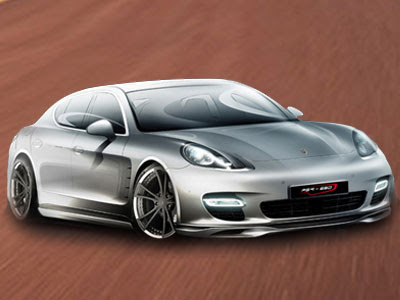
The kit brings the total output to 520bhp. The sprint of the 4.8 liter twin turbo V8 will probably be hit the 4.0 seconds. Top speed will not increase a lot but 303km/h (190mph) isn’t too bad for a four-door sedan.Set to be officially unveiled at the Essen Motor Show, the range topping PS9 features 650 hp and 890 Nm of torque thanks to bigger turbochargers, a sport exhaust system (with a sound switch), a sport catalyst, and a revised ECU. These changes enable the car to accelerate from 0-62 mph in 3.5 seconds, before hitting a top speed in excess of 200 mph. If 650 hp is too hot to handle, the company also offers more modest performance packages that allow the engine to produce 550 and 600 hp.SpeedART claims that the most powerful version of the car accelerates from zero to 100km/h (62mph) in 3.5 seconds and goes on to achieve a top speed in excess of 320km/h or 200mph.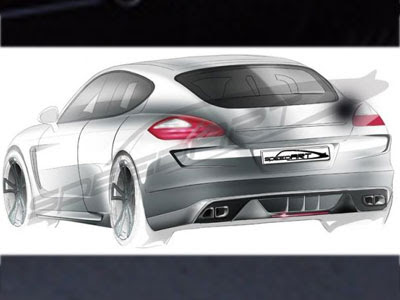
In terms of styling, the PS9 is outfitted with an aerodynamic body kit which consists of a front chin spoiler, hood vents, a rear diffuser, a roof spoiler, a modified rear bumper (with air outlets), and aggressive side skirts. Other design details include 22-inch three-piece 'LSC FORGED' wheels and the aforementioned sport exhaust system (available in polished stainless steel or matt black).Inside, the cockpit will get a SpeedART steering wheel with F1-shift paddles, real carbon-fiber trim and accents, new leather upholstery with colored stitches and a revised instrument panel.At the back, we see a new bumper, and the trapezoidal exhaust pipes. A new rear spoiler will also be mounted.
For the interior, SpeedART added a sport steering wheel with F1-shift paddles (which can be outfitted with aluminum-, wood- or carbon fiber inlays), carbon fiber trim, contrast stitching on the door panels and seats, revised instrument dials, and exclusive floor mats.

The kit brings the total output to 520bhp. The sprint of the 4.8 liter twin turbo V8 will probably be hit the 4.0 seconds. Top speed will not increase a lot but 303km/h (190mph) isn’t too bad for a four-door sedan.Set to be officially unveiled at the Essen Motor Show, the range topping PS9 features 650 hp and 890 Nm of torque thanks to bigger turbochargers, a sport exhaust system (with a sound switch), a sport catalyst, and a revised ECU. These changes enable the car to accelerate from 0-62 mph in 3.5 seconds, before hitting a top speed in excess of 200 mph. If 650 hp is too hot to handle, the company also offers more modest performance packages that allow the engine to produce 550 and 600 hp.SpeedART claims that the most powerful version of the car accelerates from zero to 100km/h (62mph) in 3.5 seconds and goes on to achieve a top speed in excess of 320km/h or 200mph.

In terms of styling, the PS9 is outfitted with an aerodynamic body kit which consists of a front chin spoiler, hood vents, a rear diffuser, a roof spoiler, a modified rear bumper (with air outlets), and aggressive side skirts. Other design details include 22-inch three-piece 'LSC FORGED' wheels and the aforementioned sport exhaust system (available in polished stainless steel or matt black).Inside, the cockpit will get a SpeedART steering wheel with F1-shift paddles, real carbon-fiber trim and accents, new leather upholstery with colored stitches and a revised instrument panel.At the back, we see a new bumper, and the trapezoidal exhaust pipes. A new rear spoiler will also be mounted.

For the interior, SpeedART added a sport steering wheel with F1-shift paddles (which can be outfitted with aluminum-, wood- or carbon fiber inlays), carbon fiber trim, contrast stitching on the door panels and seats, revised instrument dials, and exclusive floor mats.
Labels: Porsche, Porsche Panamera, Sedan, SpeedART, Spors Car, Sports Saloon, Turbo
SRS Aerokit SpeedART The Sports Car Porsche Cayman a Sporty and Elegant.
The SRS Aerokit from the German tuning firm SpeedART is a subtle and stylish way to spruce up the Porsche Cayman or Cayman S.
Unlike many bodykits which radically alter the appearance and persona of the car - sometimes for the good, but all to often for the bad - the SRS Aerokit is extremley in tune with the overall shape of the Cayman.The aerodynamic modifications include a 3-piece front chin spoiler - which provides additional downforce over the front axle, new deeper sideskirts, and an adjustable rear spoiler which has a distinct racing look to it. SpeedART have certainly taken the 'less is more' approach to design, and it's paid off.
The new Boxster and Cayman are significantly more fuel-efficient than their predecessors. The new 2.9-litre Boxer engine sips 8.9 litres of fuel per 100 kilometres (combined) – 11 per cent less than the former models with Tiptronic S. Reducing fuel consumption by 16 per cent to 9.2 litres/100 kilometres, the 3.4-litre versions with PDK offer an even greater saving.
For the first time, both models are available with a Lights Package featuring bi-xenon headlights, dynamic curve lights and LED daytime driving lights. Replacing the foglamps, these light units are made of four LEDs positioned next to one another on the Boxster, while on the Cayman four LEDs are arranged in round light units like the eyes of a dice.
PDK cars’ acceleration is even more dynamic with one of the optional Sports Chrono Packages featuring Launch Control for maximum acceleration from a standing start, while the Race Track Gearshift Strategy offers the fastest possible shifting on the track. With Launch Control, the respective models accelerate from a standstill to 100 km/h another 0.2 seconds faster. (For instance, the Cayman S with PDK and Launch Control accelerates to 100 km/h in 4.9 seconds, while the base Boxster with its new six-speed manual gearbox completes the same exercise in 5.9 seconds.)A new suspension set-up gives the new models a combination of even greater driving dynamics and enhanced comfort. Steering forces have been further reduced, giving the Boxster and Cayman even more agile and spontaneous steering behaviour.
The wheels come in new designs and are half an inch wider on the Boxster and Cayman than in the past in order to accommodate the larger brake system from the S models on the front axle. All Boxster and Cayman models feature the latest generation of Porsche Stability Management (PSM), with two additional functions: Brake Pre-Loading and Brake Assistant.
Whenever the driver lets go of the gas pedal very quickly – which is typical of an upcoming emergency braking manoeuvre – the PSM control unit builds up an appropriate level of pressure on the brakes before the driver even presses down the brake pedal, moving the brake pads slightly towards the discs, which significantly improves brake response and shortens stopping distances accordingly.
Unlike many bodykits which radically alter the appearance and persona of the car - sometimes for the good, but all to often for the bad - the SRS Aerokit is extremley in tune with the overall shape of the Cayman.The aerodynamic modifications include a 3-piece front chin spoiler - which provides additional downforce over the front axle, new deeper sideskirts, and an adjustable rear spoiler which has a distinct racing look to it. SpeedART have certainly taken the 'less is more' approach to design, and it's paid off.
A newly-enlarged 2.9-litre flat-six engine develops 255 bhp in the Boxster and 265 bhp in the Cayman, an increase of 10 and, respectively, 20 bhp over preceding models. The 3.4-litre power unit in the S versions, benefiting from Direct Fuel Injection, now delivers 310 bhp in the Boxster S and 320 bhp in the Cayman S, up by 15 and 25 bhp.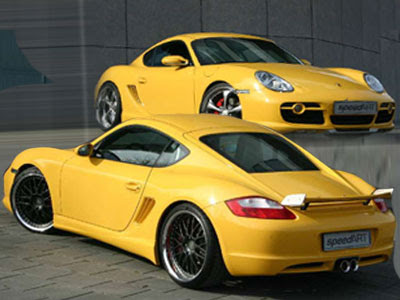

2009 SRS Aerokit SpeedART Porsche Cayman
The new Boxster and Cayman are significantly more fuel-efficient than their predecessors. The new 2.9-litre Boxer engine sips 8.9 litres of fuel per 100 kilometres (combined) – 11 per cent less than the former models with Tiptronic S. Reducing fuel consumption by 16 per cent to 9.2 litres/100 kilometres, the 3.4-litre versions with PDK offer an even greater saving.
For the first time, both models are available with a Lights Package featuring bi-xenon headlights, dynamic curve lights and LED daytime driving lights. Replacing the foglamps, these light units are made of four LEDs positioned next to one another on the Boxster, while on the Cayman four LEDs are arranged in round light units like the eyes of a dice.
The Boxster and Cayman are available for the first time with the seven-speed Porsche-Doppelkupplungsgetriebe, or PDK, which replaces the former Tiptronic S. Equipped with this double-clutch gearbox, the roadster and coupé accelerate to 100 km/h 0.1 seconds faster than with the six-speed manual fitted as standard on all models.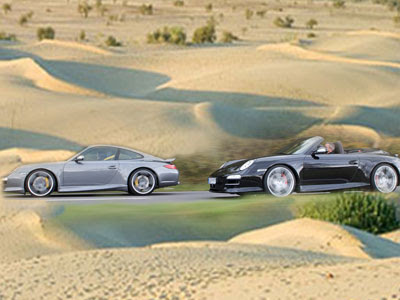

2009 SRS Aerokit SpeedART Porsche Cayman
PDK cars’ acceleration is even more dynamic with one of the optional Sports Chrono Packages featuring Launch Control for maximum acceleration from a standing start, while the Race Track Gearshift Strategy offers the fastest possible shifting on the track. With Launch Control, the respective models accelerate from a standstill to 100 km/h another 0.2 seconds faster. (For instance, the Cayman S with PDK and Launch Control accelerates to 100 km/h in 4.9 seconds, while the base Boxster with its new six-speed manual gearbox completes the same exercise in 5.9 seconds.)A new suspension set-up gives the new models a combination of even greater driving dynamics and enhanced comfort. Steering forces have been further reduced, giving the Boxster and Cayman even more agile and spontaneous steering behaviour.

2009 SRS Aerokit SpeedART Porsche Cayman
The wheels come in new designs and are half an inch wider on the Boxster and Cayman than in the past in order to accommodate the larger brake system from the S models on the front axle. All Boxster and Cayman models feature the latest generation of Porsche Stability Management (PSM), with two additional functions: Brake Pre-Loading and Brake Assistant.
Whenever the driver lets go of the gas pedal very quickly – which is typical of an upcoming emergency braking manoeuvre – the PSM control unit builds up an appropriate level of pressure on the brakes before the driver even presses down the brake pedal, moving the brake pads slightly towards the discs, which significantly improves brake response and shortens stopping distances accordingly.
Labels: Porsche, Porsche Cayman, SpeedART, Spors Car
Porsche Sport Car 9FF GT9
Porsche Sport Car 9FF GT9 the engine features titanium con-rods and forged pistons, which was necessary to handle the 987hp output. Peak torque of 964Nm falls between 5,970 and 7,850rpm.
The 911 GT3 body, on which it’s based, has also been stretched by 300mm and has had the roof lowered by 120mm to maximize downforce at high speeds. Thanks to carbon-fiber and Kevlar construction, the entire vehicle will weigh in at just 1,326kg.
Although the car is loosely based on a Porsche 911, its mechanical package has been totally revised. Ditching the 911’s rear-engine layout, 9ff engineers created a custom mid-mounted engine design utilizing the tuner’s twin-turbo 4.2L flat-six engine.
Stranded somewhere between a racing car and everyday transport,the interior of the GT9 is, it has to be said, eye cancer material. Fatthauer's genial wife decided on the race suit-style dash and door trimmings and it makes you wonder what their house is like. Luckily it's a bespoke car, so the owners will get their choice of interior and it's hard to imagine anyone demanding this one. Still, it comes with a real stereo, passenger airbag and more, transplanted deftly from the interior of a 911, and Porsche owners will recognise most of the components on display - from the ignition slot right through to the handbrake and indicator stalks.
The 911 GT3 body, on which it’s based, has also been stretched by 300mm and has had the roof lowered by 120mm to maximize downforce at high speeds. Thanks to carbon-fiber and Kevlar construction, the entire vehicle will weigh in at just 1,326kg.
Although the car is loosely based on a Porsche 911, its mechanical package has been totally revised. Ditching the 911’s rear-engine layout, 9ff engineers created a custom mid-mounted engine design utilizing the tuner’s twin-turbo 4.2L flat-six engine.
Stranded somewhere between a racing car and everyday transport,the interior of the GT9 is, it has to be said, eye cancer material. Fatthauer's genial wife decided on the race suit-style dash and door trimmings and it makes you wonder what their house is like. Luckily it's a bespoke car, so the owners will get their choice of interior and it's hard to imagine anyone demanding this one. Still, it comes with a real stereo, passenger airbag and more, transplanted deftly from the interior of a 911, and Porsche owners will recognise most of the components on display - from the ignition slot right through to the handbrake and indicator stalks.
Labels: Design Car, Porsche, Sport Car
Carrera Facelift Porsche 911 Sports Car.
MANSORY Switzerland The High-quality refining programme for the new Porsche 911.
The company Mansory is situated in Bavaria and one of the top addresses for refining premium sports cars. Whether Bentley, Rolls-Royce, McLaren, Ferrari or Porsche – the refining specialist shows its technical talent for every automobile. The subsidiary company Mansory Switzerland AG, the in-house expert for Porsche cars, presents a comprehensive tuning programme for the model 911 from the recently revived Porsche Type 997 series at the Geneva Auto Salon 2009. This tuning programme mainly focuses on improvements concerning the aerodynamics, engine performance and handling of this sports car icon.
When developing the 911-programme, the Mansory engineers attached great importance to an individual design, but also aerodynamic efficiency. In order to save weight and guarantee highest quality standards, the body components are made of composite also, parts of the serial auto body are made of this resilient and inherently stable material. The core part of the body kit is a lift-reducing front mount in a sportive-dynamic look. In connection with the hood, the front apron offers various design possibilities. On the one hand, it forms the perfect symbiosis with the serial hood, as an especially designed inlay allows a seamless junction. And on the other hand, the apron can be combined with the Mansory carbon hood whose striking side beads demonstrate individuality and underline the sportive character of the modification. The rear apron is not less impressive: it accommodates the new four-pipe exhaust system and therefore renders a harmonic rear finish. The visual perfection of the aerodynamics pack is accomplished with the side skirts which also fulfil functional tasks. They significantly calm the air flow between both axles.
The power engines also profit from the comprehensive changes of the 911 engine range. But here, the engineers do not perform any excessive open-heart surgery, but only replace existing parts by modified proprietary developments. A new sport air filter and a new exhaust system come into operation. Especially the exhaust system renders an optimised exhaust gas flow. This enable the 911 to accelerate from 0 to 100 km/h even faster than the serial versions.
But the special highlight of the exhaust system is the integrated throttle system which - if desired - can also be operated by remote control and allows changing the sound scenery.
The refining specialist developed a forged wheel with an exclusive design which was tailor-made for Porsche requirements. The one-piece wheel with five double spokes measures 8.5 x 20 inches at the front and 12 x 20 inches the back. Not only its sportive look, but also its excellent manufacture makes it so impressive. The reduction of unsprung masses by the exceptional and elaborate production technology does not only lead to a shorter braking distance, but also improves the acceleration and the handling of the car. For best possible grip, Mansory uses Michelin Pilot Sport wheels sized 245/30 at the front and 325/25 at the rear. Moreover, the newly developed running gear which lowers the car´s centre of gravity by 30 millimetres also sets sportive accents.
Labels: Porsche, Salon, Sedan, Sports Car
Subscribe to:
Posts (Atom)
